At one time or another, each of us may have thought about how well or poorly particular buildings and streets relate to their function(s), to people, and to the natural and built environment. Environment created as a result of such relationships is urban design. Some of the major elements of urban design are natural features--mountains, rivers, arroyos, vegetation--while other elements have to do with built environment, e.g., buildings, streets and street furniture, bicycles, automobiles, and buses.
Traditionally, urban design emphasized visual aspects such as edges, nodes, paths, enclosures and buffers. This vocabulary was developed and used first by urbanist Kevin Lynch for observing and analyzing a city. This concept of urban design, however, is very limiting and hard for a lay person to grasp. The visual aspects of the design are important, however, it is just as important for the design to fulfill the physical, social, emotional and spiritual needs of the people who use the environment.
Urban design is more than a combination of its elements. It is an approach to design that takes into consideration the natural and built environment, social and cultural values of the people, and aesthetics of the resulting environment. A well-designed environment is created through a thoughtful interaction of various urban design elements. A person feels comfort when an environment meets certain functional or social needs. Similarly, feelings of joy or sadness, calm or agitation may rise in response to elements and combinations of elements in the built and natural environments.
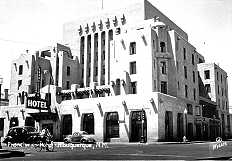
|
During its "glory days" before the 1960s, downtown Albuquerque (from Copper to Silver and from the railroad at First Street to Eighth Street) had beautiful buildings that related to each other, the street, to people, and to travel modes of the day. Gold Avenue was the financial district, with the elegant Alvarado Hotel at its eastern terminus forming a beautiful vista. As the downtown expanded in the first half of this century, Central Avenue and Fourth Street buzzed with activity. Pedestrians, bicycles, automobiles, buses, wagons, and trolleys shared the street for a time.
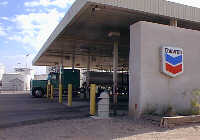 In
downtown, old gems like the Alvarado and Franciscan Hotels and several Victorian
office buildings were lost to the wrecking ball in 1960s. Cities are dynamic
and they do change. But change can be responsive to and accommodate the city's
unique history into its future. Cities like Boston and Philadelphia have continued
to effectively incorporate old historic buildings and neighborhoods into their
modern-day cities. In Albuquerque, many beautiful historic buildings were replaced
with parking lots or structures built without regard to local history, culture,
visual setting, or people. Old Town and the Albuquerque of the railroad era
were relatively compact. After World War II, however, population tripled, household
purchasing power increased, and automobiles helped individuals gain personal
freedom in choosing where to live, work, shop, and play. The city grew outward
and became highly automobile-oriented.
In
downtown, old gems like the Alvarado and Franciscan Hotels and several Victorian
office buildings were lost to the wrecking ball in 1960s. Cities are dynamic
and they do change. But change can be responsive to and accommodate the city's
unique history into its future. Cities like Boston and Philadelphia have continued
to effectively incorporate old historic buildings and neighborhoods into their
modern-day cities. In Albuquerque, many beautiful historic buildings were replaced
with parking lots or structures built without regard to local history, culture,
visual setting, or people. Old Town and the Albuquerque of the railroad era
were relatively compact. After World War II, however, population tripled, household
purchasing power increased, and automobiles helped individuals gain personal
freedom in choosing where to live, work, shop, and play. The city grew outward
and became highly automobile-oriented.
Today, automobiles dominate the streets of Albuquerque and other cities, and dictate the planning and urban design of cities, towns, and rural areas. Highways were built in the fifties and sixties to provide accessibility. Instead, they enabled an exodus to the suburbs. In the United States, the automobile has been perhaps the biggest contributing factor to the decay of inner cities.
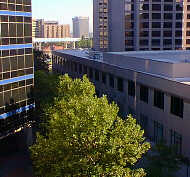 Albuquerque
has a beautiful natural setting: the Sandia Mountains on the east, the volcanic
escarpment on the west, and the Rio Grande valley through the heart of the city.
Unfortunately the built environment has yet to match the area's natural beauty.
Although the city has some examples of good urban design, much of it lacks a
sense of identity, imagination, and cohesiveness. Residential neighborhoods
are divided and hidden by strip commercial developments along wide streets with
35-50 MPH speed limits.
Albuquerque
has a beautiful natural setting: the Sandia Mountains on the east, the volcanic
escarpment on the west, and the Rio Grande valley through the heart of the city.
Unfortunately the built environment has yet to match the area's natural beauty.
Although the city has some examples of good urban design, much of it lacks a
sense of identity, imagination, and cohesiveness. Residential neighborhoods
are divided and hidden by strip commercial developments along wide streets with
35-50 MPH speed limits.
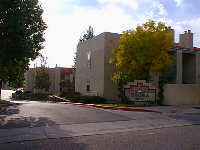 Another
possible reason for the unmanaged postwar growth is that the well-established
North and South Valley communities were economically, socially, culturally,
and politically self-sufficient; they paid little attention to the outward growth
of the city as it didn't much affect them. The change happened to Albuquerque
because of the lack of proactive planning. Recently, however, the pressures
of growth in the North and South Valleys are forcing conversion of agricultural
land into residential and commercial development and causing keen interest among
residents in planning for and protecting the special character of their valleys.
Another
possible reason for the unmanaged postwar growth is that the well-established
North and South Valley communities were economically, socially, culturally,
and politically self-sufficient; they paid little attention to the outward growth
of the city as it didn't much affect them. The change happened to Albuquerque
because of the lack of proactive planning. Recently, however, the pressures
of growth in the North and South Valleys are forcing conversion of agricultural
land into residential and commercial development and causing keen interest among
residents in planning for and protecting the special character of their valleys.
With an influx of people from other states and upward mobility of local residents, the city has continued to grow. Walled and gated communities are springing up in response to demands for safety and security against crime. While walled communities may provide a stronger sense of security, they also create visual, economic, and social divisions and disrupt street continuity and traffic.
Indifference to the design of the built environment needs to change. Unmanaged growth threatens the natural environment and quality of life. We have made great strides in improving the quality of life by providing cultural and recreational facilities such as museums, the zoo, and the botanical gardens. However, greater effort is needed to develop the city into a cohesive, exciting, safe, and aesthetically pleasing environment. The need for good urban design seems to be awakening in Albuquerque. We need to raise the general awareness, however, about the importance of urban design as an approach to balanced planning. We need to begin with a dialogue among local and state agencies, including public utility companies, schools, neighborhood organizations, professional and business communities, and the public at large. The program of Shared Vision, Inc., which started in 1992, and the city planning department's community-based planning programs provide a grass-roots venue for public dialogue on urban design.
The process of planning and designing an environment should include a healthy respect for the existing natural and built environment, social and cultural values of the community, aesthetics, and cost effectiveness.
Often economics leads the development decisions. Social, design, and environmental costs are not as easily quantifiable. For example, growth pressures are turning agriculture land in the North and South Valleys into low-density residential areas. This development may affect public access to the river, views of the mountains and bosque, the micro- climate, air and ground water quality, and availability of fresh produce for Albuquerque. There are both hidden and obvious costs in these factors; yet they are often not considered in planning, design, and implementation of development plans.
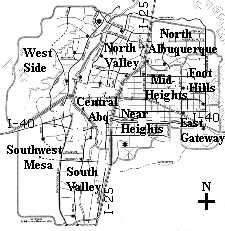 Development
on the fringes of the city requires extension of streets, water, sewer, electricity,
and telephone services. While the cost of that land may be more attractive for
the developer, development there increases installation and maintenance costs
of public infrastructure to the taxpayer. Transit service to the low-density
fringe is less feasible as well, restricting the mobility of people who don't
own a car or wish to use transit.
Development
on the fringes of the city requires extension of streets, water, sewer, electricity,
and telephone services. While the cost of that land may be more attractive for
the developer, development there increases installation and maintenance costs
of public infrastructure to the taxpayer. Transit service to the low-density
fringe is less feasible as well, restricting the mobility of people who don't
own a car or wish to use transit.
In 1975, the first Albuquerque/Bernalillo County Comprehensive Plan was developed. Even then, planners warned against urban sprawl. However, plans alone don't create healthy, functional, and beautiful cities. There must be a vision, well-thought-out plans and the will to implement them, and common goals for improving the quality of life for all inhabitants of Albuquerque. Creativity, sensitivity, and cooperation are required by the developers, planning and design professionals, various agencies, and public activists to develop, implement, and enforce the plans.
(Up to Section V, Back to Transportation - Its Role in the City, On to Urban Enhancement Trust Fund)